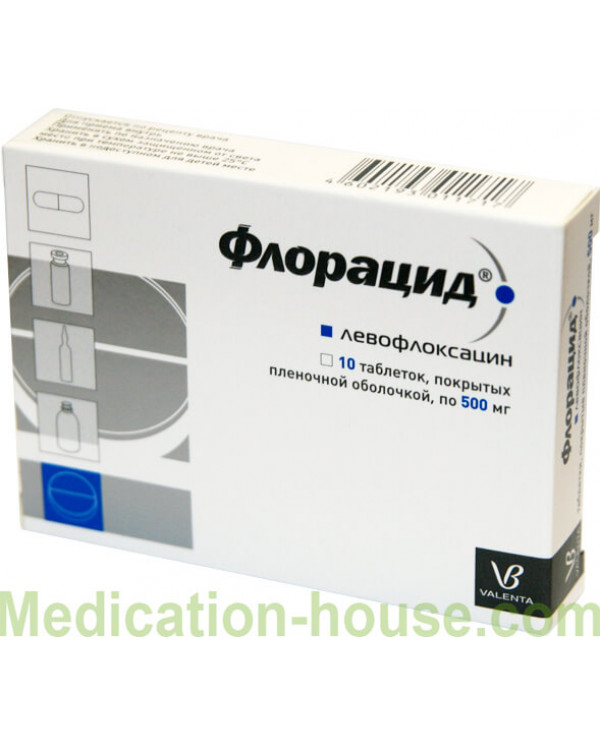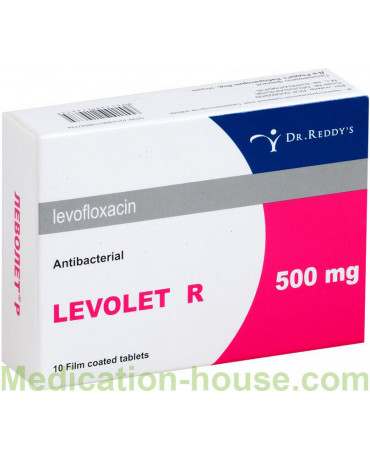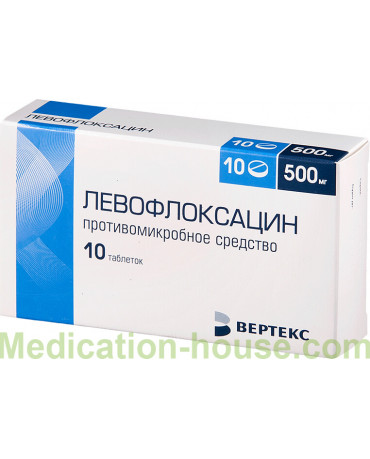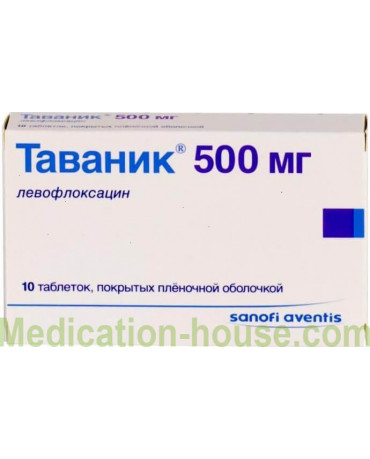Floracid instruction
You can buy Floracid here
Composition and dosage forms
Floracid is available in tablet form. The units of the drug are covered with an enteric coating. The tablets contain 250 or 500 mg of the active compound - levofloxacin. The auxiliary components are:
microcrystalline cellulose;
magnesium stearate;
polyvinylpyrrolidone;
sodium lauryl sulfate;
crospovidone.
The shell consists of hypromellose, macrogol 6000, titanium dioxide, hydroxypropylcellulose. Oblong biconvex tablets are creamy pink due to the presence of a red and yellow iron-based dye in the shell. There are risks on both sides of the medication.
In the pharmacological market there is an ointment, cream-gel and capsules of Floracid.
Pharmacological group
Antimicrobial drug belongs to the group of fluoroquinolones III generation.
pharmachologic effect
Floracid is a synthetic antimicrobial agent from the group of fluoroquinolones, the mechanism of action of which is based on levofloxacin.
The chemical compound has a bactericidal effect on pathogenic strains of infectious agents.
The therapeutic effect is based on the destruction by the active ingredient of bacterial DNA gyrase, an enzyme involved in the replication and formation of the gene structure of a microbe.
As a result of the suppression of the gyrase, levofloxacin disrupts the spiralization and cross-linking of the DNA chains. Under conditions of destruction of the gene material, irreversible changes occur in the morphological structure of the cytoplasm. The cell membrane is destroyed, the cell dies.
At the same time, the preparation is safe for human tissues, because the cellular structures of the macroorganism do not possess DNA girase.
Antibiotic active against:
Aerobic gram-negative bacteria: Staphylococcus haemolyticus, Escherichia coli, Gardnerella vaginalis.
Aerobic gram-positive microorganisms, such as Corynebacterium diphtheriae, Streptococcus pyogenes, Viridans streptococci.
Anaerobic bacteria (Bacteroides fragilis, Legionella pneumophila, Mycoplasma hominis).
When administered orally, Floracid is rapidly absorbed in the small intestine. Meal does not affect the speed and strength of absorption. Bioavailability reaches 99-100%. When released into the bloodstream, the active compound reaches its maximum concentration in 1.3 hours due to binding to plasma proteins by 30–40%. The half-life begins after 6-8 hours.
Part of the drug is transformed in the hepatocytes of oxidative or deacetylating reactions. Floracid is excreted through the urinary system. At 87% in its original form within 48 hours. 4% leave the body with feces for 3 days.
Indications for use of floracid
A medical specialist prescribes an antibiotic for the treatment and prevention of infectious and inflammatory diseases triggered by pathogenic microorganisms susceptible to the drug:
intra-abdominal infections caused by Escherichia coli;
infected wounds, burns, inflammation in the soft tissues;
uncomplicated and complicated pathological processes in the urinary system: pyelonephritis, chronic prostatitis, acute cystitis;
infectious processes in the upper (acute sinusitis, otitis media, sinusitis) and lower (bacterial bronchitis, community-acquired pneumonia) of the respiratory system.
Floracid is included in a combination therapy for treating a form of tuberculosis triggered by drug-resistant forms of pathogens. An antibiotic used in dentistry to eliminate tooth decay.
Dosage and administration of Floracid
The drug is intended for oral administration 1-2 times a day. You must take the pill whole, without grinding. It is recommended to drink Floracid on an empty stomach an hour before meals or after 2 hours after a meal.
It is important to remember that the dosage and duration of therapy is determined only by a medical specialist, depending on the individual characteristics of the patient and laboratory data. The key role in determining the treatment regimen is played by the severity of the disease, the type and localization of the infection.
special instructions
Caution should be exercised in patients with brain damage (post-stroke or post-traumatic condition), because there is a risk of muscle cramps during the period of drug therapy.
Convulsions can be intensified while taking Fenbufen, Theophylline or NSAIDs (nonsteroidal anti-inflammatory drugs).
During the period of antibiotic therapy, it is recommended to avoid walking in direct sunlight or interacting with ultraviolet light. When you receive Floracid increases the risk of photosensitivity - sensitivity to light.
After the temperature is normalized, it is necessary to continue taking the antibiotic as a preventive measure for 2-3 days.
With the development of severe diarrhea (especially with blood impurities), it is necessary to pass tests to eliminate the risk of pseudomembranous colitis. If there are positive results, you should immediately stop treatment with an antibiotic and contact your doctor. Increase the risk of developing the disease can drugs that inhibit intestinal motility.
The treatment is also canceled if you suspect tendonitis or tendovaginitis, when the tendons become inflamed. If you continue to take an antibiotic, then there may be a rupture of ligaments. Increasing the risk of the development of the pathological process simultaneous intake of corticosteroids and advanced age.
During pregnancy and breastfeeding
Levofloxacin freely penetrates the placental barrier, so the use of antibiotic during embryonic development is strictly prohibited. The active component can disrupt the tabs of the main organs and systems. It is allowed to use Floracid only in emergency cases when the danger to the life of a pregnant woman exceeds the risk of fetal abnormalities in the fetus.
When treating floratsidom you must stop lactation to avoid the development of intestinal dysbiosis in a child.
In childhood
Prohibited to use by persons under 18, because there is a likelihood of articular disorders in childhood and adolescence.
In old age
It is recommended to be careful of persons after 50 years.
Side Effects of Floracid
Digestive tract
nausea;
emetic urges;
pseudomembranous colitis;
diarrhea, flatulence, constipation;
epigastric pain;
increased activity of aminotransferases in hepatocytes;
increased bilirubin levels;
intestinal dysbiosis;
hepatitis.
Central and peripheral nervous system
dizziness and headache;
depression, hallucinations, anxiety;
muscle cramps;
confusion;
decrease in visual acuity and hearing;
tremor;
loss of sensation;
disorder of taste and smell.
Metabolism
hypokalemia, accompanied by chills and tremors;
porphyria;
increased appetite.
Musculoskeletal system
tendonitis, tendovaginitis;
rupture of tendons, ligaments;
muscle and joint pain;
weakness of skeletal muscles especially in the presence of bulbar syndrome.
Hematopoiesis
reducing the number of blood corpuscles;
agranulocytosis;
anemia;
eosinophilia.
Allergic reactions
itching, erythema, rash;
angioedema;
angioedema;
inflammation of the vascular walls - vasculitis;
Stevens-Johnson disease;
Lyell's disease;
anaphylactic shock;
bronchospasm;
swelling of the face.
urinary system
increased serum creatinine concentration;
renal dysfunction;
interstitial nephritis.
The cardiovascular system
lower blood pressure;
an increase in the QT interval;
arrhythmia, tachycardia;
vascular collapse.
Other
asthenia;
superinfection;
photosensitization;
candidiasis.
Influence on ability to drive vehicles and other mechanisms
During the period of drug therapy, it is recommended to refrain from driving, interacting with complex mechanisms and other activities that require responsiveness and concentration.
Contraindications
In particular cases, the antibiotic is prohibited or not recommended for use:
tissue hypersensitivity reactions to the structural components of Floracid or other fluoroquinolones derived from quinolones;
epileptic seizure;
children up to 18 years;
pathological process in tendons;
pregnancy, breastfeeding.
It is recommended to be careful in the presence of a deficiency in glucose-6-phosphate dehydrogenase and in persons older than 50 years, because in old age the likelihood of renal failure increases.
Overdose
When drug abuse manifests a clinical picture of overdose:
dizziness;
disturbance of consciousness;
muscle cramps;
epileptic seizures;
nausea and gagging;
ulcerative erosive diseases of the mucous membranes of the gastrointestinal tract.
The adverse agent has not been developed, and therefore treatment is directed to the elimination of symptoms or manifestations of overdose. Hemodialysis is ineffective.
Interoperability and compatibility
With simultaneous use of floracid with other drugs, the following reactions are observed:
Therapeutic antimicrobial effect is reduced when taking sucralfate, antacids containing magnesium or aluminum, iron salts. When prescribing a combination therapy, it is necessary to observe the interval of 2 hours between the use of different medicines.
Reduces the manifestation of seizures on the background of the techniques of quinolones, Fenfuben, antiepileptic drugs.
When using a group of vitamin K is required to control blood clotting.
The excretion of Floracid is slowed by Probenecid, Cimetidine.
Glucocorticosteroids increase the likelihood of tendon rupture.
Levofloxacin increases the half-life of drugs from the group of cyclosporins.
With alcohol
There is incompatibility with ethyl alcohol, which is part of the alcoholic beverages. Ethanol increases the toxic effect of Floracid on the liver cells. Because the alcohol compound is metabolized in hepatocytes, the liver cells do not have time to recycle the dangerous chemical compounds. As a result of overloads, there is a massive death of heptocytes, and the fatty degeneration of the liver begins.
When the toxic effect on the body is increased, the fluoroquinolones, due to the presence of a halogen radical, begin to cause negative manifestations on the part of the nervous system.
Terms and conditions of storage
It is required to keep Floracid in a dry place, limited from sunlight, at a temperature of up to +25 ° C. Do not allow the ingress of antibiotic in children's hands. Shelf life - 2 years.
Reviews
Irina
Because of the work there was no time to treat bronchitis. I thought viral, will pass if you drink antipyretic. When the attacks of dyspnea began and the temperature exceeded 39.5, she went to the hospital. The doctor said it was an infection and prescribed Floracid tablets. He said that this is an antibiotic and you need to drink it together with probiotics, so that it does not cause dysbacteriosis and does not reduce immunity. She was skeptical and wary, but the pain in her chest made her begin treatment. Surprisingly, after 3 days I was able to breathe normally, but the temperature did not fall. Descended only on day 5 of treatment.
Terms of sell
You can buy Floracid without a prescription.




